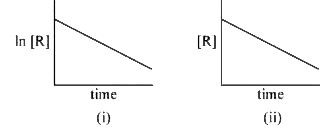The given plots represent the variation of the concentration of a reactant R with time for different reactions (i) and (ii). The sum of orders of the reactions is ________ .

Video Solution
Text Solution
The correct Answer is:1
axa−xx
For 1st order reaction
+dxdt=k(a−x)1
∫dxa−x=∫kdt
−ln(a−x)=kt+c
If t=0

If t=0
c=−lna∴−ln(a−x)=kt−lna or ln(a−x)=−kt+lna v m x C
Similarly
R(A0)(A)→P
−d[R](A)dt=k[R]0

or −d(R)=kdt or ∫d[R]=−∫kdt
[R]=−kt+c or [A]=−kt+cy=mx+c
|
Topper's Solved these Questions
Similar Questions
Knowledge Check
The half-life of a reaction is halved as the initial concentration of the reactant is doubled. The order of the reaction is
A0.5B1C2D0The half-life of a reaction is halved as the initial concentration of the reactant is doubled. The order of the reaction is
A0.5B1C2D0The half-life of a reaction is halved as the initial concentration of the reactant is doubled. The order of the reaction is
A0.5B1C2D0
When initial concentration of a reactant is doubled in a reaction, its half-life period is not affected. The order of the reaction is
View SolutionIn a first order reaction, the concentration of the reactants is reduced to 25% in one hour. The half-life periof of the reactions is
View Solution[r]= concentration of reactant and t be the time
_2019_CBT3_E01_012_Q01.png)
Identify the correct option for order-
View SolutionA : Rate of reaction depends upon the concentration of the reactants.
R : The order of reaction can be negative with respect to substance present in the reaction.
View SolutionA plot of logarithm of rate vs logarithm of concentration of the reactant in a first order reaction is straight line whose slope is tanθ, where θ is
View Solution


